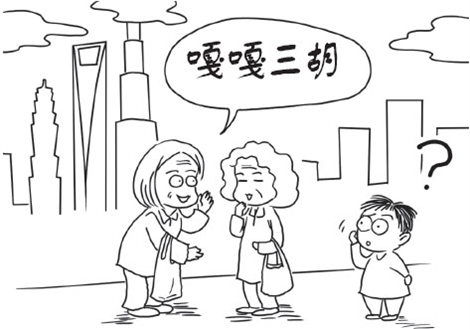Loss of dialect a crisis for ancient language
- By Huang Shaoyun
 0 Comment(s)
0 Comment(s) Print
Print E-mail Shanghai Daily, August 9, 2013
E-mail Shanghai Daily, August 9, 2013
“Ga san hu” is now what you may hear every day if you are a loyal listener of the 2012 radio program A La Ting Xin Wen (Let’s listen to news).
|
|
|
[By Zhou Tao/Shanghai Daily] |
Many people were curious about the meaning of ga san hu. In fact, that is a phrase in Shanghai dialect simply meaning “chatting,” but what is shocking is that among those who could not understand, quite a few are local youngsters.
Some data indicate that only 60 percent of native Shanghai students can catch the meanings and speak dialect fluently.
“Academic circles have been concerned with the crisis of Shanghai dialect since the 1990s, and now, thanks to new media such as weibo, the voices are becoming louder and louder,” said associate professor Huan Tao from the Chinese Language and Literature Center of Fudan University. “Many other places in China are also facing dialect crises,” he said, citing Sanming and Yongan in Fujian Province, which he said are losing their dialects at a faster pace than that of Shanghai. But the big-city cases are getting more attention.
On December 25, 2011, 82 scholars published the Appeal for Scientific Preservation of Shanghai Dialect. They urged that kindergarten, primary and secondary school students should be allowed to speak dialect after class, that the city’s public transport system should have signs in Shanghai dialect, and that shanghai dialect-only radio and TV channels should be established to teach the correct characters and pronunciations of the language.
During 2012, voices for preservation became louder.
In March, the China Sound Data Bank of Linguistic Resources started the collection and recording of the phones in Shanghai Dialect; in June, a local news program called Xin Wen Fang started a Shanghainese-only weekend version; in July, four versions of transportation card bearing children’s story rhymes were sold out soon after their release. A No. 4 bus route started using announcements in dialect. In August, the first Shanghai dialect neighborhood club named Ga San Hu Club was formed to preserve and pass on the dialect.
In 2013, efforts reached higher levels. In addition to the dialect-learning activities in many communities, the Shanghai Municipal Education Committee announced a plan to use dialect by teaching folk rhymes and traditional children’s games in kindergartens.
Reasons of dialect decline
A Shanghai dialectcartoon called Wang Xiaomao the Buffoon was aired on the Children’s Cannel during summer vacation and is said to be popular.
However, what exactly caused the gap in speaking dialect?
Zhou Haiwang, vice director of Population & Development Institute of Shanghai Academy of Social Sciences, conducted a survey about the relatively low status of Shanghai dialect in primary and secondary students daily use of the language.
He found four major reasons. First, their parents, born mostly in the 1970s and 80s, were themselves the first generation that started to lose Shanghai dialect. Second, Shanghai schools, like schools everywhere, require Mandarin (Putonghua) to be used in teaching; there are no lessons on dialect. Third, too many immigrants from other parts of China and overseas are destroying the “colloquial” environment. Fourth, since some modern words have no dialect equivalent, some people choose to use putonghua for precision.
In my opinion, there are three other factors that widen the gap.
1. Since modern technology is developing at a blistering pace, putonghua has become irresistible in TV, radio, films, games, electronic devices and the Internet.
2. The decreased number of households where three generations of locals live together also means children have fewer chances to learn dialect from their grandparents.
3. In nursery schools and kindergartens, putonghua is taught and used in the teaching of every subject. This can destroy the dialect-acquiring environment.
And there are grave implications, the first being the crisis of Shanghai culture. Shanghai dialect, as an excellent part of local culture, reflects the attitudes and characteristics of Shanghai natives. Dialects are part of the Chinese language and demonstrate the diversity of Chinese culture. If diversity of language is lost, so is the diversity of culture.
Anyone with basic knowledge of ancient Chinese must know that many dialects have preserved pronunciations, words and even grammar of old Chinese.
Beautifully rhymed
Shanghai dialect is no exception. It is said that the language used in the Tang (AD618-907) and Song dynasties are more like Shanghai dialect or kejiahua.
In fact, some poems written in that period that read strange in putonghua can rhyme perfectly when read in Shanghai dialect.
Take the famous poem “Nostalgia for My Brothers on Double Ninth Day” written by Wang Wei as an example: Du zai yi xiang wei yi ke, mei feng jia jie bei si qin. Yao zhi xiong di deng gao chu, bian cha zhu yu shao yi ren.
Read in putonghua, the last words qin and ren of the second and forth sentences are not in rhyme, but when the reader switches to Shanghai dialect, the word ren is read as nin and the poem is beautifully rhymed.
Shanghai dialect contains a great amount of information about the ancient Wu culture and early Chinese language. The ancient pronunciations, words and grammars preserved in Shanghai dialect are a great legacy from our ancestors.
It is also a fact that almost all of the 50 phonemes in Shanghai dialect, which are considerably more than the 18 in putonghua, can almost all be found in the most widely used foreign languages.
The author is a student at the Shanghai University of International Languages. Shanghai Daily condensed the article.







Go to Forum >>0 Comment(s)